Here's a link (no registration required) to the New York Times report on Walt's nephew resigning the Disney Board of Directors. There will be fallout from this.
Monthly Archives: November 2003
V for Victory
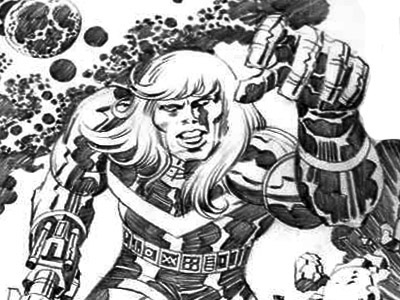
Around the time the original Star Wars was packin' 'em into theaters, a group of entrepreneurs approached Jack Kirby about starting a comic book company to be called Kirby Comics. They had some money and expected to soon have enough to launch such a business, and they offered Jack what on paper was really the only great deal ever presented to him in comics, post-Marvel. He would do a series of graphic novels that would be the company's initial offering, to be followed by more books, some by him, some by others. The pay was good, Jack would have an ownership position in the company and, most important, he could retain clear, uncontested title to his new creations. But of course, there were downsides — one small, one big. The small one was that they insisted the first book be not unlike Star Wars. Jack was torn by this. He never liked to feel like he was "following" someone else, and he had a minor resentment of the whole Star Wars phenomenon, feeling that some key elements of the film were inspired by his own work. On the other hand, Jack had a certain pride in being able to do something good with any premise. To him, there was no such thing as an idea that he couldn't make work in a fresh, innovative way. The other downside of the project was that when Jack was about two-thirds of the way through his first graphic novel, which he called Captain Victory and the Galactic Warriors, the entrepreneurs ran out of loot and the whole project collapsed.
The almost-finished Captain Victory story languished in Jack's closet until San Diego comic book dealers Steve and Bill Schanes decided to launch a comic book company that would, among other innovations, allow creators to retain copyright to that which they created. They approached Kirby, and he decided to unleash Captain Victory. Pacific Comics, as the Schanes brothers dubbed their new firm, would be publishing not graphic novels but conventional-sized 32-page comics, so Jack chopped up the first Captain Victory story to fit that format, and thereafter continued the saga with new stories. While at the time I didn't think it was the best thing Jack ever did, I've met an awful lot of people who count it among their favorite Kirby comics. Having found that Jack's work only improves with time, I keep meaning to haul out my copies of the series and re-read them.
Even better, I'll probably experience them anew with Captain Victory: The Graphite Edition, which is a new book from TwoMorrows, publishers of The Jack Kirby Collector. This volume reprints the first story in its "graphic novel" form. More importantly, it is reproduced from Xeroxes of Jack's original pencil art, not from the version that was lettered and inked by others, thereby giving you Kirby in its purest form. Jack had Xerox copies of many of his stories in the pencil phase, and the TwoMorrows company is now engaged in a most worthwhile project, which is to preserve and restore those Xeroxes. All proceeds from this new book are going to that effort, and that alone would be well worth your patronage. But the "Graphite Edition" is also a treasure, in and of itself, packed as it is with raw Kirby and many special features, including a screenplay of the material that Jack once wrote. For fans of Jack, it's a must-own.
Captain Victory: The Graphite Edition is not available in stores. You can only get it directly from TwoMorrows, and you can get it at this website. If you're familiar with Jack Kirby's work, you're there already.
Black in Black and White
As I've mentioned, my favorite of the "newer" stand-up comedians is a guy named Lewis Black. If you haven't seen him, go see him. And either way, you might want to read this interview with the man.
My thanks to Ben Varkentine for calling this to my attention. So I'll return the favor and suggest you visit Ben's weblog. He's a bright guy with stuff to say.
About Walter Tetley
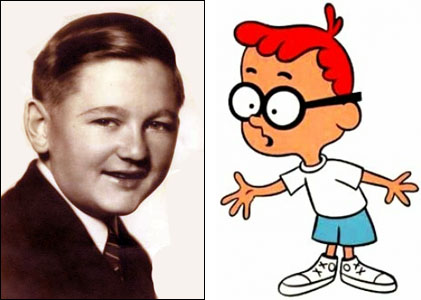
That's a photo of the late Walter Tetley. Now who the hell, you're probably asking yourself, was Walter Tetley? Explanation: Walter Tetley was an actor with a high enough voice that he spent his life playing kids on radio and in cartoons. His most notable radio voice was as Leroy, nephew of The Great Gildersleeve. His most notable animation work was voicing Sherman, the kid who got into the Wayback Machine with Mr. Peabody and went back in time on the various Rocky & Bullwinkle programs. He was also the voice of Andy Panda for a time, and did some brief on-camera roles, usually as a kid or a delivery boy. His long and tumultuous career is examined in a new book, Walter Tetley: For Corn's Sake by Ben Ohmart and Charles Stumpf. You can order a copy at this website. Sounds interesting to me.
Castle Films
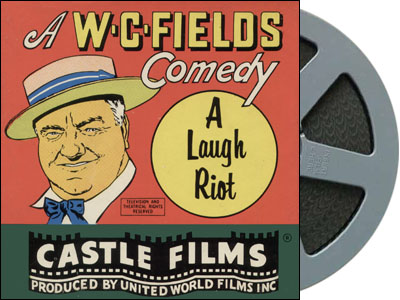
For no visible reason, I found myself thinking about Castle Films this morning…and about how in this age of home video, they seem so primitive. Castle Films was for a time the leading manufacturer of 8mm movies. They were sold in camera shops and in the back of Famous Monsters of Filmland magazine, and a lot of us thought it was the neatest thing to be able to own and show a copy of Dracula or a Woody Woodpecker cartoon at home, even if it was silent and cut down to 4 minutes. That's not quite as bad as it sounds because a few of those old Universal horror films and comedies didn't lose all that much in that format. The one reel, non-talkie version of Abbott and Costello Meet Frankenstein just about encapsulated everything that was fun about that cinema classic.
Castle Films was founded in 1924 by a man named Eugene Castle. This was before 8mm. Castle distributed 16mm movies — mostly newsreels and sports highlights — sold almost exclusively via mail order and in photography shops. There was also a successful business selling prints to film rental companies that would rent them out for non-theatrical exhibition…say, at a school or club function.
In the thirties and early forties, the main Castle product was what were called "soundies," which were short films that were the music videos of the day. In some bars and restaurants, you could put a dime in a machine and view a "soundie" of Glenn Miller's orchestra playing their latest record…or you could buy a Castle Film of it and watch it over and over and over at home. In the post-World War II years, there was a huge uptick in the market for 16mm projectors, so Castle Films sold a lot of "soundies." Around 1947, the company was so successful that Mr. Castle sold it to a company called United World Films.
His timing was great. Soon after, another company stole the rights to the "soundies" away and Castle Films lost its most important item. To fill the void, the new owners made a deal with Universal Studios to release scenes from some of their movie musicals on 16mm and this led to them also putting out excerpts from other Universal movies, most notably Abbott and Costello films, monster movies and the Walter Lantz cartoons (like Woody Woodpecker and Andy Panda) that Universal distributed. They continued to also market newsreels and travelogues and also began releasing films in the 8mm format that was becoming increasingly popular for home movies.
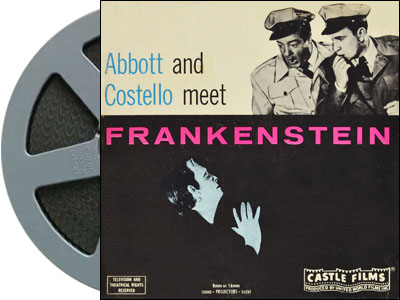
There was a certain artistry in the editing. Most Castle Films came in two versions…a 50-foot reel (3-4 minutes) and a 200-foot reel (12-16). Someone had to take an 85-minute movie and edit the abridged versions, preferably selecting action with a minimum of dialogue. The technology of motion picture production marched in reverse as they made silent films out of talkies, adding in title cards where necessary. The editors for Castle were pretty good about keeping them to a minimum.
Around 1949, Castle Films figured into a notable Hollywood "first." Though their popularity was on a definite decline, Bud Abbott and Lou Costello were still among Universal's highest-grossing stars. Their manager, the legendary Eddie Sherman, had actually secured for them a contract that paid them a percentage of the profits from their films…almost unheard-of at the time. Oddly, though Universal remained eager to put out more Abbott and Costello films, the studio maintained that the films were not breaking even…ergo, no profit checks to Bud and Lou. It was an early example of "Hollywood Accounting," in which the books are juggled so that all sorts of expenses are charged against the film, thereby reducing its net on paper, making it possible for the studio to argue that there are no profits to share.
Sherman knew his boys were being cheated but he was in a chicken-and-egg quandary. He could not get a look at the accounting ledgers unless he sued the studio…and he couldn't find a basis on which to sue the studio if he couldn't see those ledgers. One day, while walking down Vine Street in Hollywood, he passed a camera shop with a window display for Castle Films of Abbott and Costello. That was the excuse he needed. He sued Universal on behalf of his clients and gained access to the books, which displayed all manner of financial irregularity. They wound up settling out of court for a very large sum of cash, but it was probably the movie industry's first dispute of the sort, starting a tradition that continues to this day and now involves DVDs.
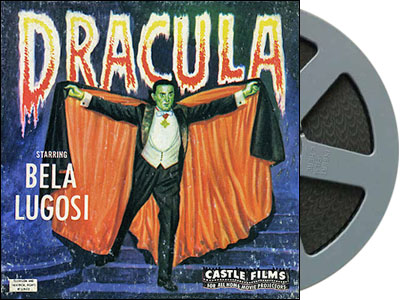
Castle Films dominated the home movie market to such an extent that their name almost became generic. To this day, one sees eBay merchants auctioning off the product of competing films like Blackhawk Films, Atlas Films, Ken Films or Entertainment Films…all referred to as"Castle Films," in much the same way most people refer to any brand of facial tissue as "Kleenex." Throughout the sixties, their top sellers were the films featuring the classic Universal monsters (Frankenstein, Wolfman, Dracula, etc.) and those starring Abbott and Costello. Rumor has it that, no surprise, their all-time best-seller was Abbott and Costello Meet Frankenstein. But the mostly widely-available Castle Film was a 4-minute chop-down of Abbott and Costello Meet the Keystone Kops entitled Have Badge, Will Chase, which was used as a kind of low-cost introductory film to, they hoped, get people hooked on Castle Films. Issued in the hundreds of thousands, it came free with one popular brand of 8mm movie projector and when that deal soured, leftover copies were dumped on the camera store market as loss leaders. At a time when other 4-minute Castle Films cost $6.00, Have Badge, Will Chase went for $1.98 or less. As a result, it was the only Castle Film that some people ever owned.
16mm died out for them in the mid-sixties, which was about when 8mm sales hit their peak. Universal Studios acquired an increasing percentage of the company until eventually they owned it all and renamed it "Universal-8" — or sometimes, "Universal Super-8," as the Super-8mm movie format became more popular. Ironically perhaps, Universal chose to diversify beyond their own catalogue and began licensing the rights to put out movies owned by others. Almost every other major studio also tried establishing an 8mm division but it was too late. The market fell off during the seventies, not just for movies you could show at home but for all 8mm equipment. Even before the Betamax and home video recorders appeared on the scene, most 8mm film companies were defunct. The former Castle Films operation seems to have put out its last items in 1981.
Folks who still own 8mm projectors (an increasingly-scarce device) still sometimes collect Castle Films for the nostalgia. There isn't a lot of point to even threading the Bell and Howell to run a silent excerpt of Dracula when the entire movie, with sound, can be rented at Blockbuster and popped into the VCR. But some of us still hold a fond memory for the days when you could actually run a movie for your friends in the comfort of your own home. At the time, that seemed like a very big deal.
Lost: One Cartoonist
So whatever happened to Bill Watterson, creator of the comic strip, Calvin and Hobbes? This article won't tell you a lot but it will tell you something.
The Iron Horse
Lower ratings seem to agree with Larry King. Like most of his one-time fans, I've watched his interviews deteriorate over the last decade…watched him lob more softballs than all the ladies' baseball teams combined. For a long time, he seemed to think that it was less important for his guests to address important issues than for them to enjoy being on Larry King Live and want to come back. Maybe the guests did but audiences haven't been flocking back to him. But lately, he seems to be trying harder. Maybe it's better preparation by his staff. Maybe it's that he hasn't been divorced lately. Whatever it is, he seems to be trying harder.
The bad side of that is more shows about the Laci Peterson case, the Michael Jackson case, etc., and more bogus authorities. When Jermaine Jackson complained about the media giving air time to people who falsely claim to know his family, he probably had Larry in mind. I really wish King (and others on the cable news channels) would raise the standard of what constitutes an expert, an intimate friend or a spokesperson. Larry King Live keeps featuring these "panels" of six people, only one of whom has anything of substance to say.
But one thing Larry has to offer is a long friendship with most of his celebrity guests. He's lately out of his element on newsy topics but pretty good with show biz veterans…and he is kind of a legend. Saturday, CNN is rerunning a special show that ran on the 19th to celebrate Larry's 70th birthday. It started out as an hour with Regis Philbin but about five minutes in, Regis announces that the rest of the hour is actually a surprise birthday party for Larry. Dr. Phil takes over the host chair while Larry moves over to be guest on his own show, claiming to be utterly surprised. I suspect he was not, but you can judge for yourself if you catch it on Saturday. Most of the hour is a cavalcade of stars showing up live, via remote or pre-tape, to wish King a happy seventieth. The list includes Mike Wallace, Jay Leno, Nancy Reagan, George and Barbara Bush, Wayne Newton, Liza Minnelli, Dick Cheney, Tony Bennett, Sharon Stone, Madonna, Ross Perot, Bill Maher, Cher, Don Rickles, Jimmy Carter, and on and on. Weirdest of all is a live remote to Jerry Lewis in some hospital somewhere with an oxygen line taped into his nose. It's the oddest moment in a very odd hour.
Mouse Hole
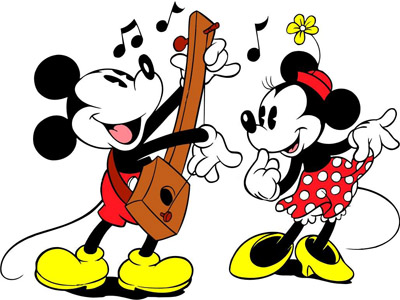
As this article in The New York Times notes, the Disney organization is struggling to make Mickey Mouse as popular as…well, as popular as Mickey Mouse oughta be. There are a couple of obvious reasons why he isn't, one being that his best work is being hidden. The Disney Channel and Toon Disney rarely feature the classic Mickey cartoons, and the home video releases have been more slanted to the collector market. The comic strips are gone and the comic books are sparse in their availability and tend to treat Donald and Scrooge as the superstars. Yes, Mickey presides over Disneyland and Disney World and is well-represented therein…but only because he has the job. He's increasingly becoming like one of those faux celebrities who is famous only for being famous. You wake up one morning and folks are insisting on his greatness but you never get to see it; ergo, you never fully accept it. So how is a kid to fall in love with The Mouse? And when Mickey's classic adventures are accessible, do they not seem a bit grounded in an earlier, unfamiliar era?
Those are good questions and the solution obviously has to do with generating great new Mickey adventures in several venues. But this brings us to a major stumbling block that inevitably diminishes every great character that is controlled by a corporation: Too Many Bosses. If you were to roam through the Disney organization, you'd find hundreds, maybe thousands of folks who have some sort of "executive" position and what they think is a clear take on what to do with Mickey. They're not all wrong but they're not all right in the same way. Which creates massive gridlock and unhappy compromises since they won't concede to having no say in Disney's signature asset. Not long ago at another big corporation which shall remain nameless (it was Time-Warner), I had a meeting with a mid-level exec who at that moment had nothing to do with Bugs Bunny…and boy, was she pissed. The lady had every intention of rising up in the Time-Warner hierarchy to better jobs with bigger salaries, and that meant she had to get some control over The Wabbit and his immediate cohorts. It was demeaning that she was excluded from Bugs projects, just as I gather it's demeaning in a non-entertainment company situation if you don't get to eat in the Executive Dining Room or tinkle in the Executive Washroom. Don't think that kind of thing doesn't happen in any corporate situation, and Disney is no exception.
Ideally, what Disney needs to do is to find one cartoonist or one small group and appoint them to be Mickey Dictators. Give them the power to define Mickey anew and to say no to anything that involves Mickey the way Walt once could…and did. But no one high up in Disney is about to exclude themselves from such decisions. This has always been true but it's truer now than ever. Once upon a time, people who went to work for a company like that envisioned long careers, staying there forever, if possible. The business has changed. Now, the mindset is that everyone's a temp, and you want to get as much as you can for as long as it lasts. That means rising up quickly in the company and not caring a lot about the long-term health of its properties, which leads to something as symbolic as Mickey Mouse being caught in umpteen tugs-of-war. Every office, every division wants a piece of Mickey, which means that key decisions are made, if they're made at all, by committee. With a committee, it may go in as a Mouse or a Duck or a Wabbit, but when it comes out, it's always The Camel. One of the main things that made Walt Disney as successful as he was was that he didn't have to fight anyone to prove he was in charge. And of course, he expected to be with the company for the rest of his life.
Let's Twist Again
Here's a brief news story on the lawsuit 'twixt Todd and Twist. Nothing you don't already know, but it does indicate that some pressure is growing for the Supreme Court to get involved.
No Claus for Alarm
And now, it seems Harvey Fierstein will not be playing Mrs. Claus in the Macy's parade. Here are the details.
Recommended Reading
Here's an article by Eric J. Greenberg on the impact of Jews in comic books, with special focus on Joe Kubert. The piece has a few errors in it (Captain Marvel was created by C.C. Beck and Bill Parker, not Beck and Otto Binder; Bob Kane's real name was Bob Kahn), but it's otherwise pretty good.
Currently at The Hill
There's lots of good stuff to read over at Jim Hill Media, like this profile of Sub-Mariner creator Bill Everett, this piece about Mickey Mouse's relationship with the Macy's Thanksgiving Day Parade, and this rundown of musicals that Disney may or may not bring to Broadway. Alas, they no longer have columns by my pal Jim Korkis, but he's been replaced by another expert on animation history, Jackson "Pop Culture" King. Here's King's latest. Good stuff.
Lost Treasures
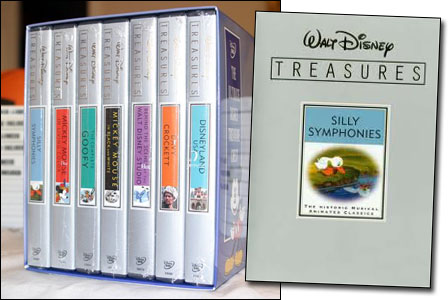
Here's a tip that will make some animation buff very happy…and don't thank me. Leonard Maltin just told me about it. Disney Home Video has been releasing a series called "Walt Disney Treasures," which feature rare Disney films and cartoons on DVD. These are the ones that come packed in those little tin boxes, and they are starting to go out of print. As they do, they begin selling on eBay for…well, for a lot more than Carl Gottlieb's pants. If you missed them, you missed some terrific, must-have video gems. Obtaining the first seven now could run you $350 and up.
There is, however, an alternative. Disney has put together a slipcased set of the first seven called "The Walt Disney Treasure Chest." You don't get the tin boxes but you do get the first seven DVDs in a cardboard sleeve for $124.99. What's the catch? Just this: You have to belong to Costco. This set seems to have been produced only for them as a Christmas item. It may not be available anywhere else and it may not be available once Costco finishes selling whatever quantity they've purchased. It should be in the Costco stores any day now if it isn't already there, or you can pay postage and get one from the Costco website (Do a search for "Disney Treasure"). If you aren't a member, you can either pay 5% extra or join Costco, which costs $45.
By the way: Costco is also selling that new Pioneer DVD-TiVo I mentioned recently for $779.99. If you've been thinking of getting one, that's a pretty good price. I'm still quite happy with mine.
Claus for Alarm
Guess who's playing Mrs. Santa Claus in the Macy's parade on Thursday! If you're registered to read articles at the New York Times website, you can read this article by the future Mrs. Claus and some comments on what it all means.
Buy Carl Gottlieb's Pants!
Carl Gottlieb is a writer, producer, director and actor with a list of credits to die from. I just called and left a message on his voice mail informing him that someone on eBay is selling his pants!